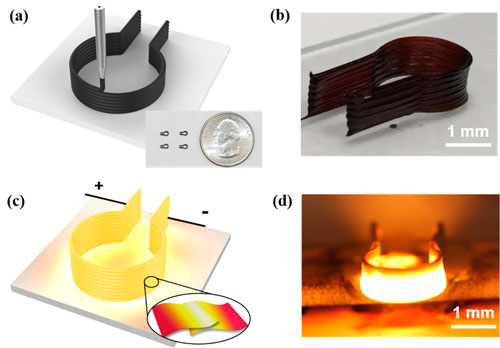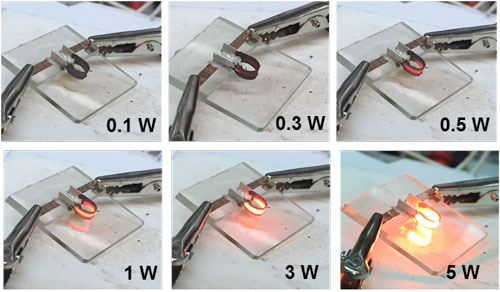| Posted: May 19, 2016 | |
Miniature 3D-printed high-performance heaters |
|
| (Nanowerk Spotlight) High-temperature heaters, such as furnaces, are widely used in chemical reactions, materials synthesis and device processing. The limitations of these heating devices often are their bulky size, weight, low maximum heating temperatures and slow ramp rates. Laser heating, on the other hand, is expensive, has poor temperature distribution throughout the sample, and is highly dependent on the absorption of the target material. | |
| To overcome these limitations, and to provide a heating element with a high temperature range to the target object in a micro- and nanoscale environment, researchers have developed a 3D-printable high-temperature, high-rate heater that can be applied to a wide range of nanomanufacturing when precise temperature control in time, placement, and the ramping rate is important. | |
| "Our 3D-printed heater uses graphene oxide," Yonggang Yao a graduate student in Prof. Liangbing Hu's research group at the University of Maryland, tells Nanowerk. "When electrical current is applied to this heater, it can generate high temperature (∼3,000 K) with exceptional fast rate (in less than 100 millisecond, an estimated heating rate ∼20,000 K/s) and superior stability (>2,000 cycles, with continuous high temperature lasting for more than a day without noticeable decay). | |
| The team has reported their findings in the May 6, 2016 online edition of ACS Nano ("Three-Dimensional Printable High-Temperature and High-Rate Heaters"). | |
 |
|
| Figure 1. Schematic demonstration of 3D printable heater. (a) High concentration GO ink was used for 3D printing of RGO heater. Arrays of 3D printed heaters with chamber size 1.5 mm are also shown in the inset. (b) Photo image of as-printed horseshoe-like 3D heater. (c) The operation of RGO heater at high temperatures is achieved by applying a driving current. The contact area between two RGO flakes is expected to experience a higher temperature due to larger contact resistance. (d) Photo image of 3D printed RGO heater under high temperature operation. (Reprinted with permission by American Chemical Society) (click on image to enlarge) | |
| The heater can be printed in various 3D shapes with highly concentrated aqueous graphene oxide ink, enabling fast and low cost prototyping design for customized heating and miniature of heater size down to micrometer scale. | |
| With their current 3D printer setup, the researchers have printed horseshoe-shaped heaters with feature size down to 200 µm. | |
| After carbonization, the graphene oxide becomes reduced graphene oxide (RGO) that is stable under high temperature and under high vacuum and can function as a high-performance heater. | |
| By contrast, conventional furnaces or heaters are not printable simply because the printability (flexibility) and high temperature durance (stability) in most materials are mutually exclusive. | |
| "The high temperature is provided by Joule heating, a simple, highly efficient and finely controllable way to generate high temperature in conductive materials," explains Yao. "No metal or ceramic based furnaces/heaters can reach such a high temperature since most metals melt and ceramics decompose at such high temperature." | |
 |
|
| Figure 2: Heating process with increasing input power. (Image: Bing research group, University of Maryland) (click on image to enlarge) | |
| The contact resistance between graphene oxide flakes can generate a large amount of heat when electrical current is applied. The high rate comes from the miniature size of the heater which concentrates the thermal energy. | |
| Joule heating was firstly applied to RGO as a simple and highly controllable source for high temperature heating. | |
| The highly stable covalent carbon-carbon bonding enables stable performance of the heater even at high temperatures. | |
| Due to the 3D printing technique and the unique viscoelastic property of the graphene oxide inks, this work provides a facile and fast strategy to design and develop thermal elements with arbitrary architecture and variable dimensions. | |
| Since the heater performs excellently under high vacuum, it can act as a microscale heating source inside electron microscopes for in situ observation of temperature related morphology and structure changes in materials. | |
| Also, the researchers note that, since the Joule heating method is simple and the device can be very small, the heater can be used in space for high temperature welding or thermal treatment during spacecraft repair work. | |
| Going forward, the team will demonstrate applications inside microscopes for in situ observation of high temperature effects provided by the 3D heater. They also plan to develop nanoscale heaters. | |
| "In the current stage, the size of our heating element measures in microns; our goal is to achieve 3D nanoprinting," Hu concludes. "So far, this has been a challenge for us, which requires us to learn more about the graphene oxide inks and designing new 3D printers. In addition, we hope to increase the temperature from 3,000K to even higher temperature that can be potentially used to explore the unknown properties of materials in such extreme high temperature environment." | |
 By
Michael
Berger
– Michael is author of three books by the Royal Society of Chemistry:
Nano-Society: Pushing the Boundaries of Technology,
Nanotechnology: The Future is Tiny, and
Nanoengineering: The Skills and Tools Making Technology Invisible
Copyright ©
Nanowerk LLC
By
Michael
Berger
– Michael is author of three books by the Royal Society of Chemistry:
Nano-Society: Pushing the Boundaries of Technology,
Nanotechnology: The Future is Tiny, and
Nanoengineering: The Skills and Tools Making Technology Invisible
Copyright ©
Nanowerk LLC
|
|
|
Become a Spotlight guest author! Join our large and growing group of guest contributors. Have you just published a scientific paper or have other exciting developments to share with the nanotechnology community? Here is how to publish on nanowerk.com. |
|
